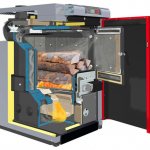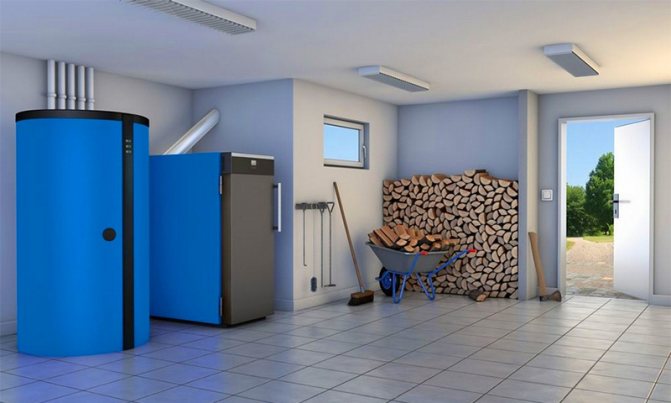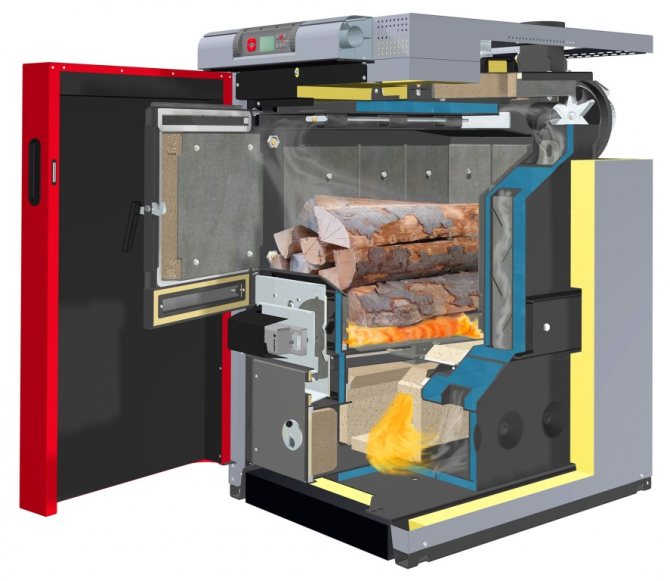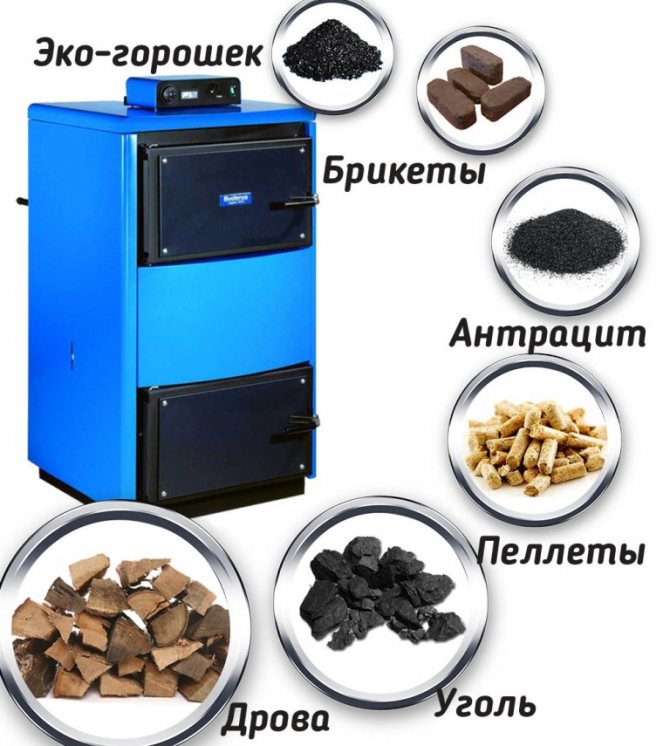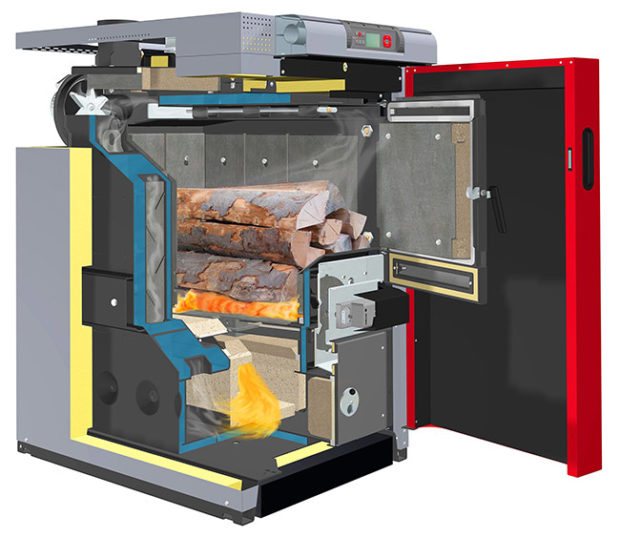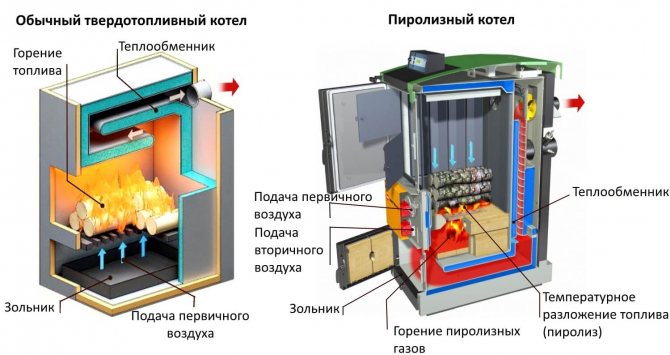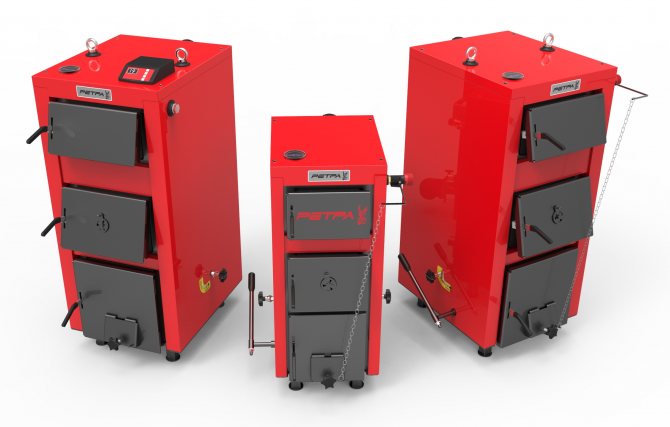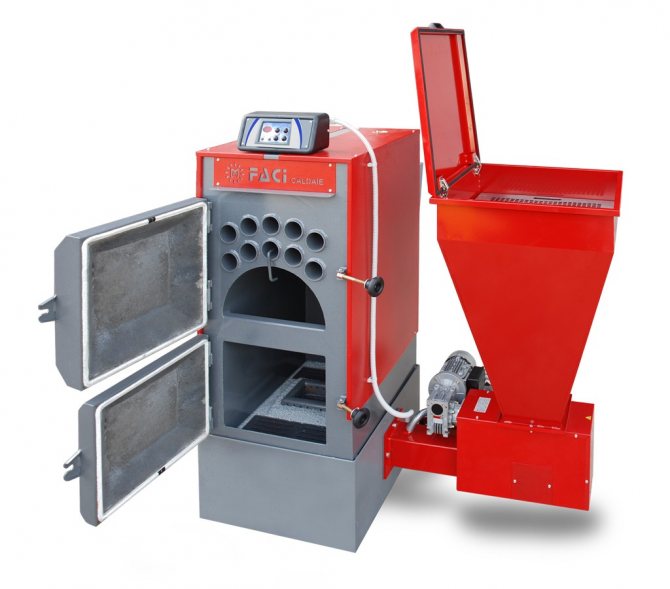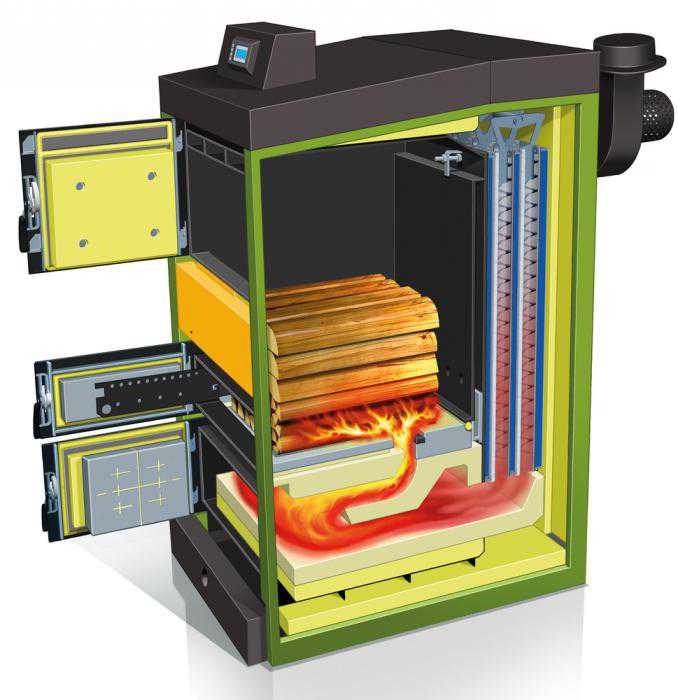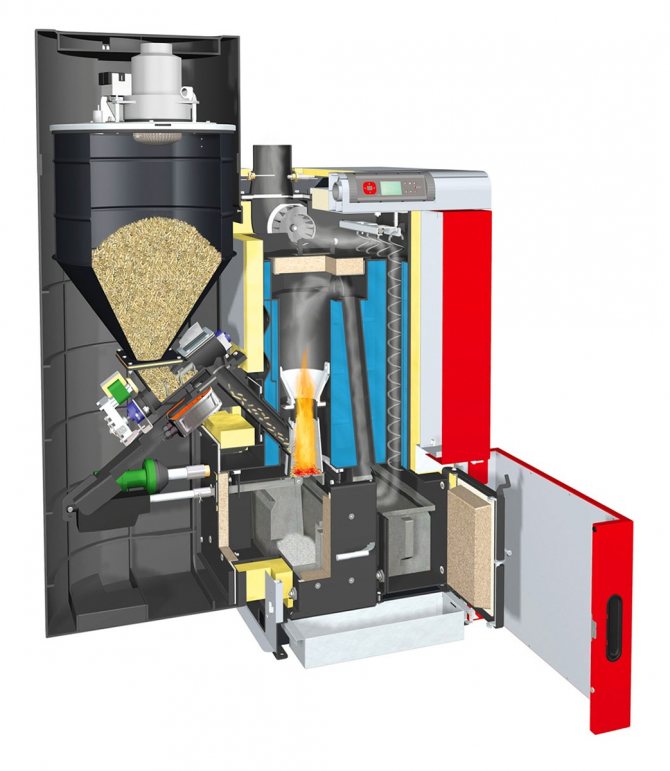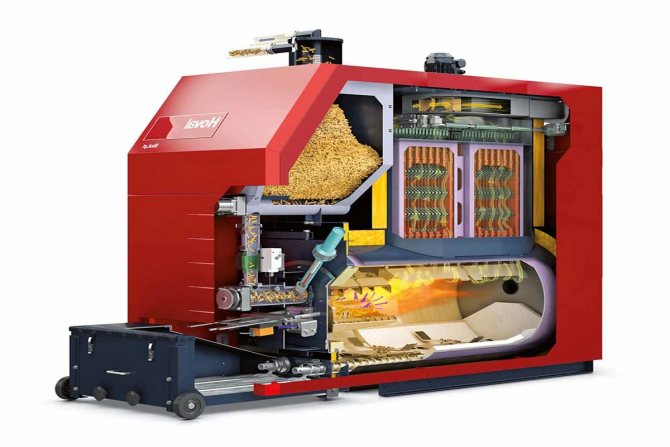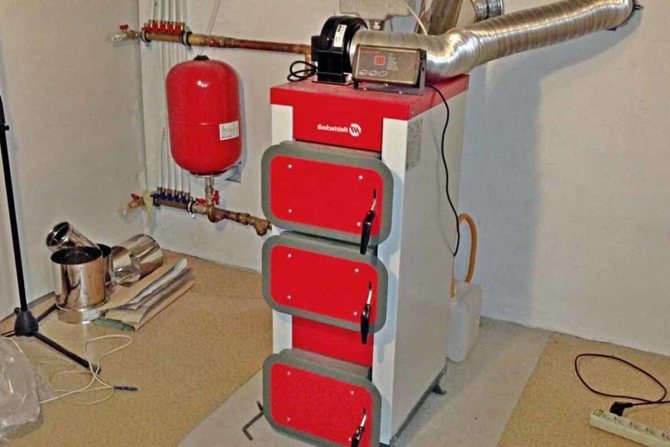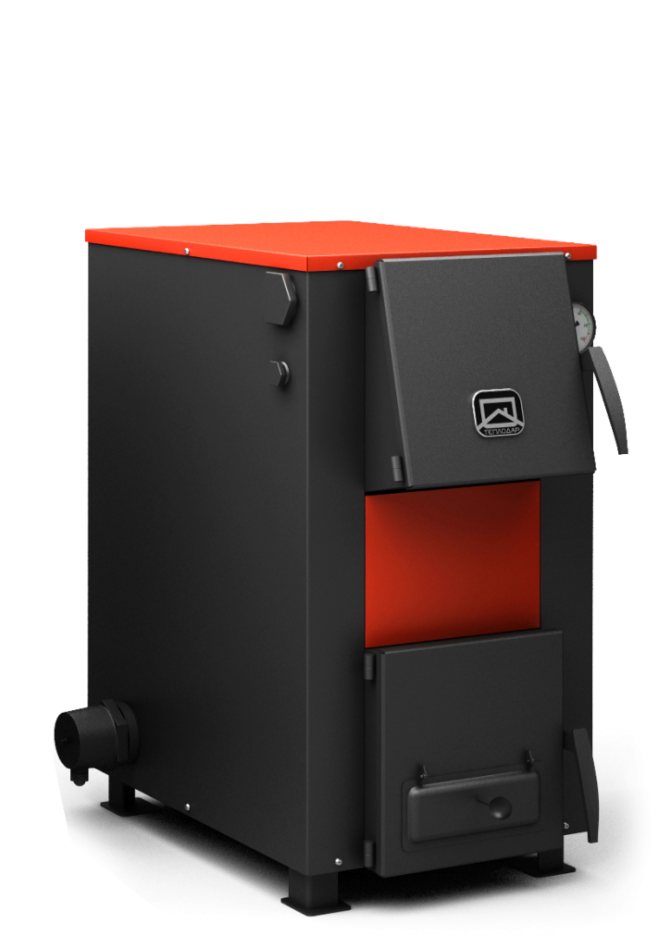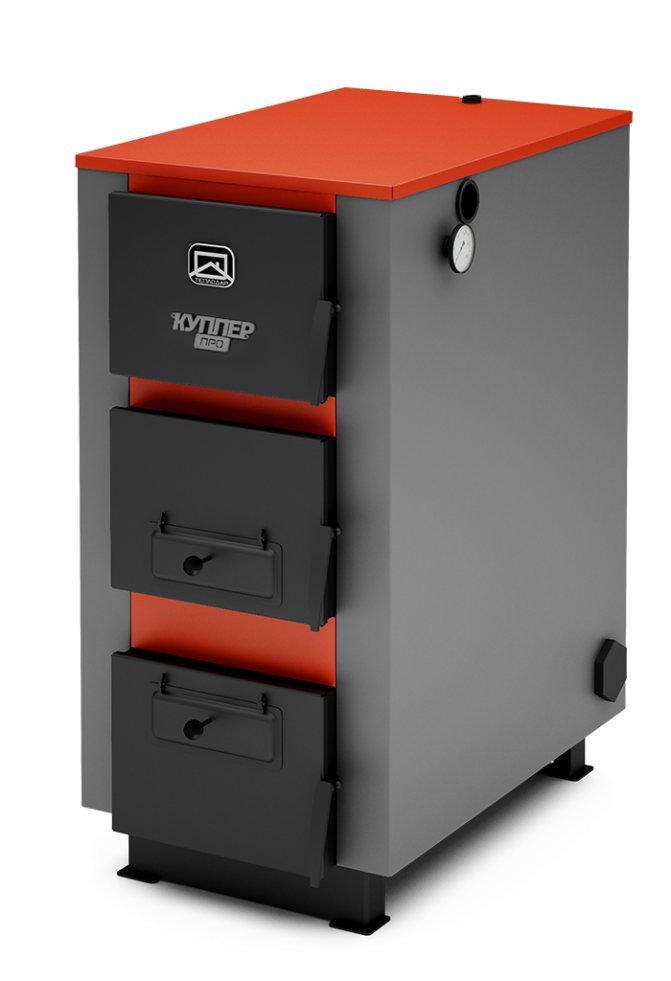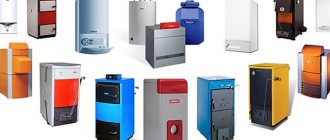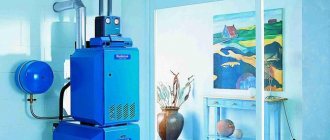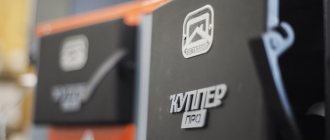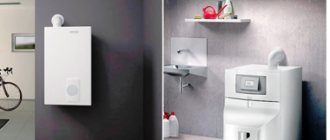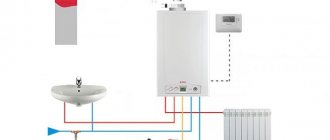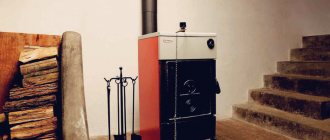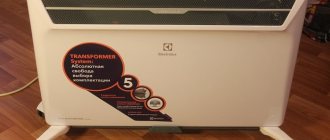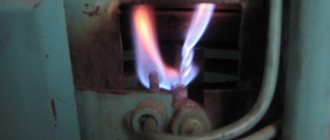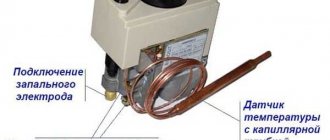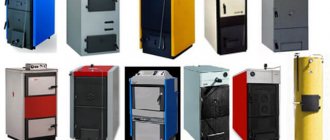# 1. Briefly about the principles of work
It would seem that difficult in a solid fuel boiler? I threw wood or coal into the furnace, they burned out, heated the water, and the house was filled with warmth. In general, everything is true, but the principle of operation of the device is somewhat more complicated. In the design of a modern solid fuel boiler, the following main elements can be distinguished:
- firebox;
- coolant circulation system;
- smoke removal system;
- safety system;
- heat storage system.

IN firebox fuel is supplied and burned to obtain heat. This is the classic version. There are pyrolysis boilers in which solid fuel (wood) smolders, releasing gas, which then burns, providing heat. At the same time, the efficiency increases somewhat, but we will deal with the peculiarities of the operation of classic and pyrolysis boilers later.


The firebox is a large container with double walls, between which there is coolant... In most cases, this is water, less often an antifreeze liquid or a mixture of water and antifreeze is used. The coolant receives heat from the burnt fuel, circulates through pipes and radiators, heating the air in the house. Cooling down, the water returns to the boiler again and everything is repeated. Often special pumps are used to improve circulation.
When fuel is burned, not only heat is generated, but also gases that must be removed. The system is intended for this. smoke removal... The chimney removes gases from the boiler to the street, sometimes a forced ventilation system is used to increase the efficiency of this process.
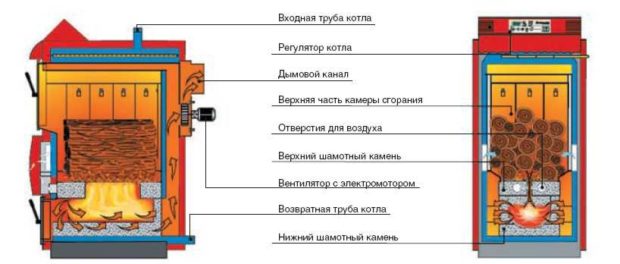

The most great dangerthat can happen when a solid fuel boiler is running is overheating of the coolant... The water may already be sufficiently heated and the boiler will continue to generate heat. If the water boils, the heating system may not be able to withstand it, especially if the house has metal-plastic pipes that are sufficiently sensitive to high temperatures. It is almost impossible to stop the combustion of firewood or coal - all that remains is to reduce the intensity, and so that the overheated coolant does not get into the system, they use cooling heat exchanger... It receives cold water from the water supply, but in case of a water cutoff, it is better to always have a sufficient supply of it.
The cooling heat exchanger can be built into the boiler or between the boiler and the rest of the heating system. It can only be built into the structure of a steel boiler. It works in one of two possible ways:
- first option - cooling of the heated coolantwhich passes through a cooling heat exchanger. Cold water is supplied to the cooling heat exchanger through a thermal valve, which opens when the temperature of the coolant reaches + 950C. The process continues until the coolant cools down to a safe temperature;
- the second option provides for the presence shut-off valve... If the water temperature rises to critical values, the valve does not allow it to flow into the pipes. Cold water is supplied to the heat supply system from the water supply system, and the overheated coolant is drained into the sewer. True, the water pressure should be sufficient, and its composition should not contain an increased amount of salts, which will provoke the formation of scale.
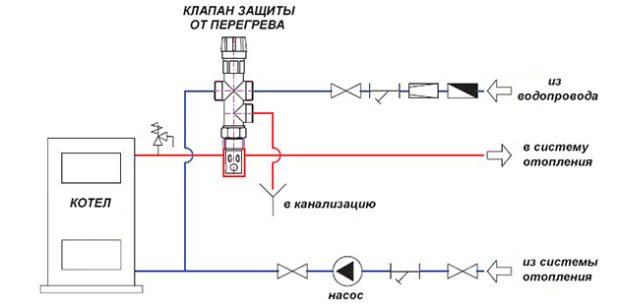

Dumping heated water into the sewer is not very smart and economical, therefore, it is better to supplement the design of a solid fuel boiler storage tank... This is a buffer between the boiler and the rest of the heating system, thanks to which a number of important functions:
- warm water accumulation for its further use, and this is fuel economy, comfort, stability in maintaining the temperature and a decrease in the number of trips to the firebox for tossing fuel;
- protection against accidents... In the tank, overheated water is mixed with warm water;
- the ability to use boilers of different types... The storage tank will be common for a solid fuel and, for example, a gas or electric boiler, will allow you to simply organize a single heat supply system at home and insure yourself with several heat sources.

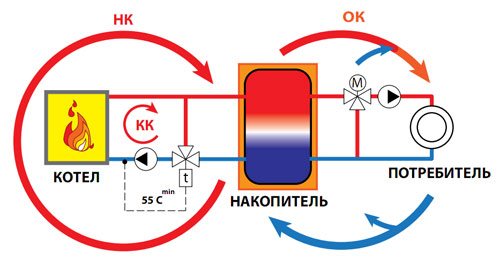
Heat accumulators are made of cast iron or steel and receive powerful thermal insulation. Buffer volume, first of all, depends on the power of the boiler: for each 1 kW, it is necessary to provide 25 liters of tank volume. The quality of this element of the heating system must be of the highest, therefore it is better to trust the products of well-known manufacturers. The online store https://www.duim24.ru/ presents heat accumulators only from trusted companies, the assortment includes tanks of different volumes and materials of manufacture.
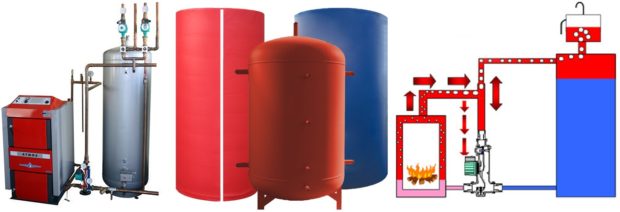

Solid fuel boiler in the home heating system
It is necessary to choose the optimal piping scheme for the boiler with the heating system. Here's the best way to do it.
- Mixing unit. It is necessary to install a jumper pipe for the supply and return. The jumper will act as a mixer, where hot water flows from the supply circuit, then passing into the return. At the same time, the temperature can be regulated in the return section in the heating circuit. A separating valve must be installed on the jumper. With such a system, heating will be carried out as usual until the temperature begins to drop to a critical threshold. Then the automatic connection will work if the boiler is equipped with control automatics. If it is absent, then you will have to manually open and close the shut-off valve and monitor the temperature of the coolant. In this case, you cannot do without a thermometer.
- Installation of a buffer tank. Its connection to the heating system will allow you not to be tied to the heating device with the need for constant fuel filling. The buffer tank accumulates heat energy. It contains water inside it, heated in the supply circuit of the heating circuit. Then the heated water from the container gives up its heat to the coolant. Such a capacity divides the entire heating system into two parts: the heating boiler and the radiators of the heating system.
For the tank, it is recommended to install another mixing unit in the system. There are also more complex piping schemes for a solid fuel boiler with a heating system, but they make sense only in the absence of automation of the boiler equipment, while today on the market most proposals are directed towards automatic regulation of the row processes.
# 2. Types of solid fuel boilers according to the principle of operation
With a similar general scheme of the device, different types of solid fuel boilers have some design nuances. The entire existing assortment can be divided into the following types:
- classic or traditional boilers;
- pyrolysis or gas generating boilers;
- long burning boilers;
- pellet boilers.
Classic solid fuel boilers
Such boilers are a lot like ordinary stoves. The heat is obtained here as a result flaming fuel... As a rule, firewood or coal is used as the latter. Fuel is supplied through one door, and through the other - the boiler is cleaned of ash and other products of incomplete combustion. Traditional boilers can have both cast iron and steel heat exchangers, usually used in natural circulation systems.
Although the efficiency of this type of device is not the highest, they are valued for reliability, because the design of the boiler has a minimum of electronic elements that can fail. The only automation element is a temperature controller, but it also works on a mechanical principle. Classic boilers are durable and rarely require repairs.
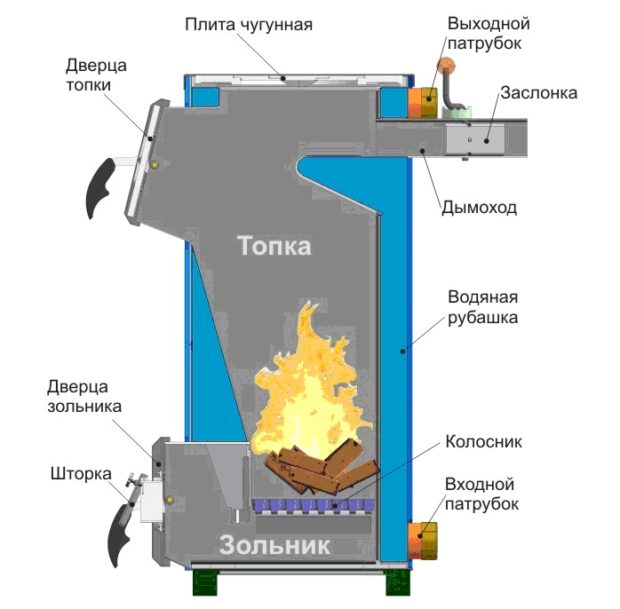

Pyrolysis boilers
Pyrolysis (gas generating) boilers are somewhat more complicated. Their design contains two combustion chambers... Solid fuel (firewood) is put in the first, at high temperature and oxygen deficiency occurs pyrolysis process with the release of pyrolysis gas. It goes into the second chamber, where it burns and gives off heat to the coolant. Only charcoal remains from the firewood.
The combustion temperature of pyrolysis gas is higher than that of firewood, which increases the boiler efficiency by up to 90%. If we take into account the fact that the process of wood decay is slower than its combustion, then we can talk about another advantage - one fuel fill is enough for 10-13 hours (for classic boilers, this figure is 5-7 hours). The fuel used is hardwood and low moisture content (no more than 20%).
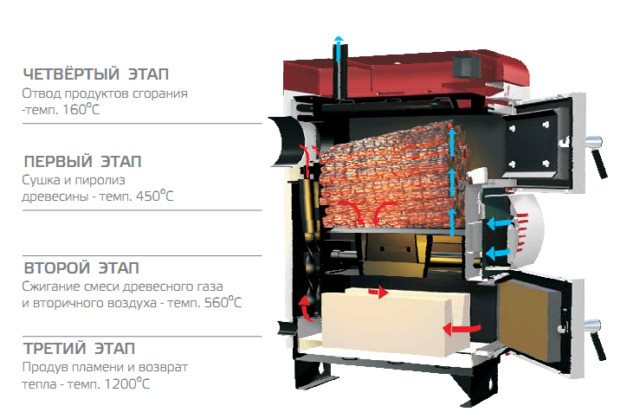

Long burning boilers
This type of boilers resembles pyrolysis boilers in many ways, but differs in some technical features. Solid fuel smolders in the first chamber, forms gases that burn out in the second furnace. In this case, only the upper part of the fuel is involved in the process of smoldering and combustion. Due to this, it has to be loaded less often, and the efficiency increases. One load of firewood is enough for the boiler to work two days... The main disadvantage is the high cost of the equipment.
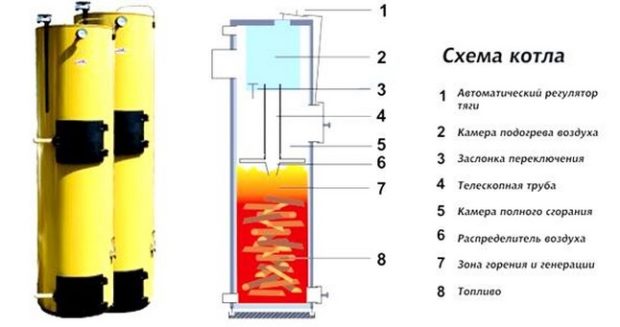

Pellet boilers
They are also often referred to as automatic boilers. According to the principle of operation, they differ little from traditional ones, but besides the firebox, they have bunker for storing a stock of fuel. This means that it will not be necessary to often come up and pour fuel into the furnace manually - everything will be done by automatic equipment. Approximately 7 days... In addition, such a system can be very precisely adjusted for yourself. Fuel is considered one of the most environmentally friendly at the moment. Pellets are granules that are produced from wood waste (sawdust, shavings, etc.). The efficiency of such systems is 91-95%, the only drawback is the high price of boilers.
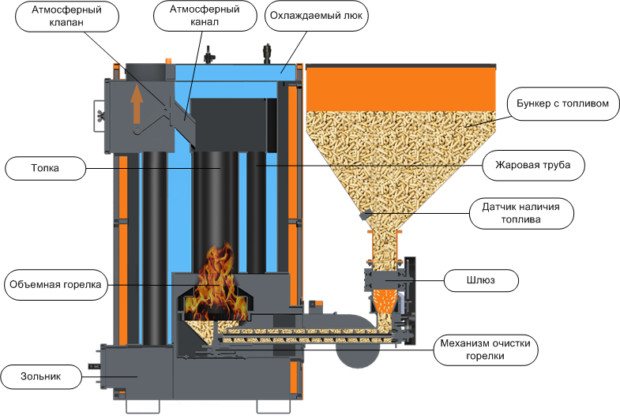

Ten best models of solid fuel boilers
10+. ZOTA Pellet 100A
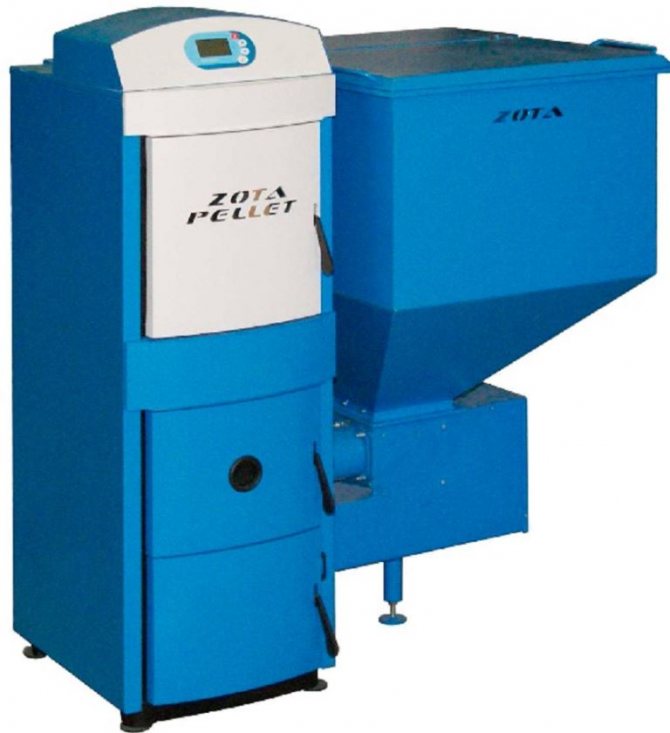

This is a pellet-type boiler, which is characterized by a high level of process automation, when the device is capable of operating for several days without additional refueling with combustible materials. The design provides for a screw feed of fuel and the presence of an inflatable fan, it is perfect for the harsh Russian climatic conditions. The maximum power of the equipment is 100 kW, the volume of the fuel hopper is 606 liters. Due to the screw feed, absolute protection against overheating is provided, it also prevents the penetration of flame into the fuel storage bunker.
The built-in thermostat sends the device to standby mode when the required temperature is reached The boiler is connected to the electrical network, from which all the automation functions, it has an automatic ignition. Adjustment of the main parameters is carried out using the buttons located on the body of the device. Automation allows you to keep under full control the daily fuel consumption, making the boiler more efficient and economical. Additionally, you can install a GSM module that allows you to remotely control the temperature in the system. The unit is able to heat a building with an area of up to 800 square meters.
Benefits:
- Screw fuel supply;
- The presence of an electronic control system for all elements;
- High power;
- High efficiency - about 90%.
Disadvantages:
- The need to connect to the mains;
- Significant weight of the device.
ACV TKAN 100
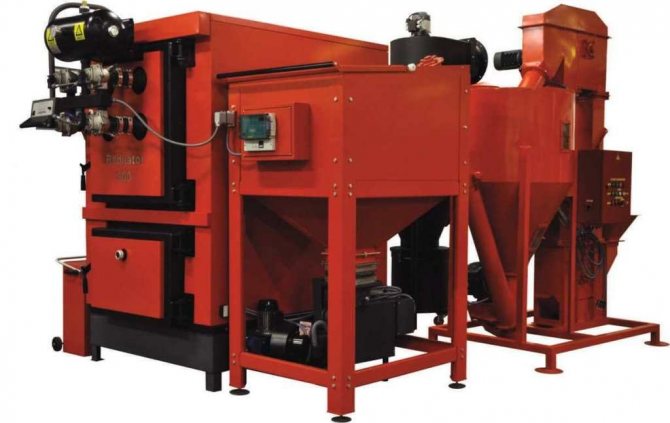

Fully automated device that uses coal, wood braces, wood and so on for fuel.It has a high efficiency - about 93%, fuel consumption is low - from 8 kg per hour when the boiler is set to maximum performance parameters. The boiler is absolutely safe during operation thanks to its fully sealed combustion chamber and forced air supply. The fuel delivery mechanism is equipped with a fire damper.
The convective part is equipped with a pneumatic cleaning system; there are special grates for the convenience of using solid fuel. The maximum heated area is 300 sq. m. The highest pressure in the heating system is 3 bar. The device is equipped with an automatic system powered by electricity, so the boiler needs to be connected to the mains, the burner ignites on its own. The main settings are set using a special panel located on the unit body.
Benefits:
- Not the largest mass of the product;
- High rated power and efficiency;
- Availability of electronic automation ensuring safe operation and compliance with all set modes;
- The fuel is supplied by means of a screw mechanism.
Disadvantages:
- High price.
ZOTA Poplar М 20
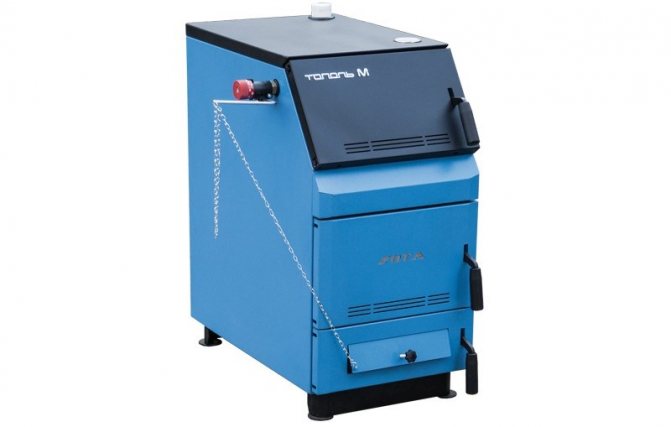

The boiler is distinguished by high reliability and a very attractive design solution. The fuel loading is vertical, an automatic-type draft regulator is provided, there is a gas burner connected directly to a household gas pipeline or to a cylinder, there is a reliable heating element.
The maximum heated area is 150 square meters with a ceiling height of 3 meters. In the heating system, the highest pressure is 3 atmospheres, its volume is designed for 54 liters. The housing has good thermal insulation. There is a water jacket under the decorative cladding, which prevents the boiler from overheating, it is additionally covered with basalt cardboard, due to which the heat loss becomes minimal. The firebox door is equipped with a lock, one load of fuel burns out within about 12 hours. The boiler must be connected to a natural chimney, as its design does not include a fan.
More: Japanese robot vacuum cleaner cleverPANDA i5 - full review of hybrid robot vacuum cleaner
Benefits:
- The burner is economical, due to which the fuel consumption is reduced, and the heat output increases;
- Autonomous management;
- The ability to use several types of solid fuels;
- Significant performance indicators - over 90%;
- Reliable build;
Disadvantages:
- Great weight.
Teplodar Kupper Practitioner 8
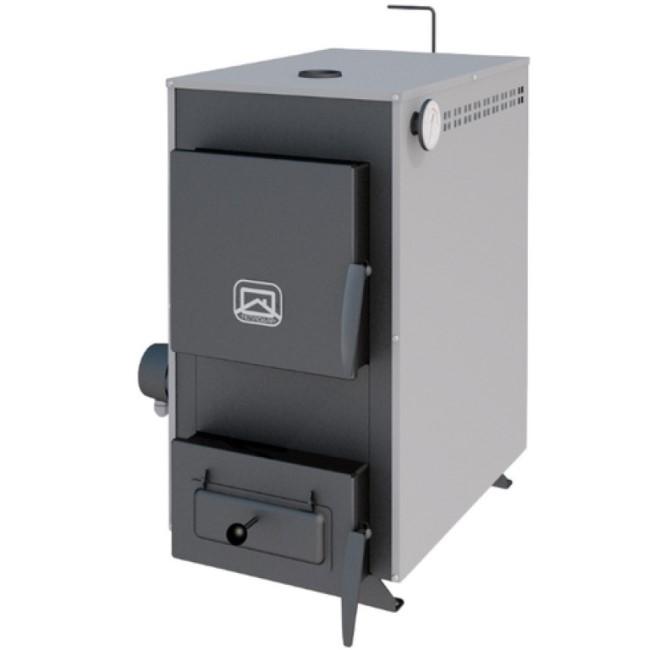

The device is intended for placement in residential buildings and other premises, the area of which should be in the range from 40 to 80 square meters. m. The products are universal, respectively, they are allowed to be used both in closed and open heating systems. The way of circulation of the coolant does not play a special role - the device works stably with both artificial and natural methods. The boiler can be used as an independent source of thermal energy, but it is often installed as an addition to existing systems that run on gas, electricity or liquid fuel. The boiler comes with a poker, a thermometer, a rotary gate and a shurovka. The device is characterized by small overall dimensions - it takes up the minimum amount of space in the room.
If necessary, the design can be improved with an automatic draft regulator. This device allows you to control the intensity of combustion, which significantly saves fuel. The product is suitable for any heating systems, even made of small-volume polymer pipes, but in this case they must be connected through a special hydraulic separator of a capacitive type.The casing-convector here is of a perforated type, due to which the room where the boiler is located is additionally warmed up. The supply pipe is located on the upper surface of the structure, it is able to provide versatility of the connection and protect the system from air ingress. The furnace is inclined, the fuel is evenly distributed in it. The damper damper is made of cast iron, with its help you can protect the room from spilling smoldering slag and coals.
Benefits:
- Universal product capable of operating on any solid fuel;
- Completely safe and well thought out design;
- High efficiency and efficiency.
Disadvantages:
- It is required to be placed in a separate room;
- The installation is quite complicated - it is problematic to perform it yourself.
ZOTA Enisey 12
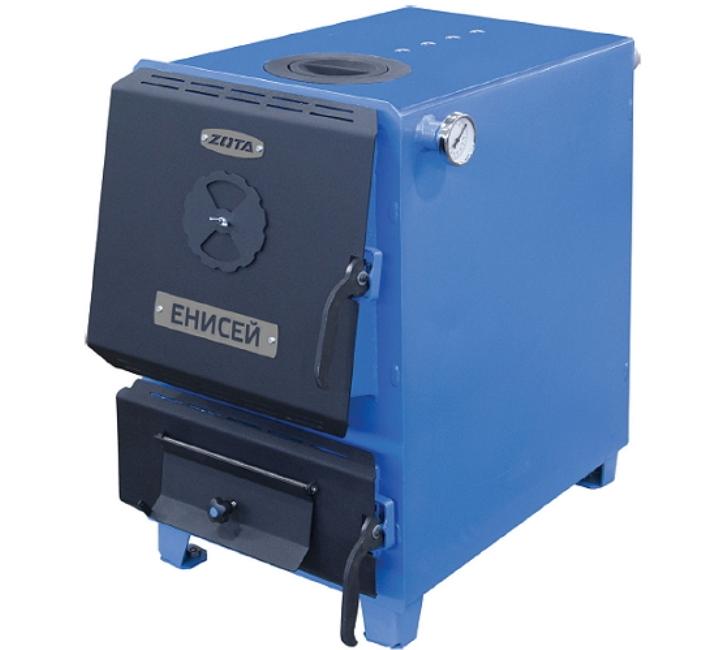

It has a very deep firebox, so it will be possible to load firewood up to 60 cm long into it. The firebox is made at a certain angle, so it will be much more convenient to fill the combustion chamber with bulk fuel. The loading and ash doors fit tightly enough to the main body of the boiler, do not let the combustion products into the room, and air will not enter the combustion chamber through them. This, in turn, will have a positive effect on traction. The combustion process can be controlled by a special air supply damper. There is a thermometer on the side wall of the apparatus, which shows the temperature of the water leaving the boiler. If necessary, you can install a mechanical draft regulator, but it will have to be purchased separately - it is not supplied with the boiler.
Electricity can be used here as an auxiliary heat source. For this, the boiler is equipped with special stainless steel heaters. The water jacket is located along the entire boiler circuit, including under the ash pan. Due to this feature of the apparatus, the amount of heat transferred to the coolant increases, and deformation of the ash box does not occur either. Benefits:
- Decent rate of efficiency;
- Can work with any solid fuel;
- It is possible to install additional parts;
- High quality workmanship;
- The doors fit tightly to the body.
Disadvantages:
- Maintenance of the device is somewhat problematic.
EVAN WARMOS TT-18
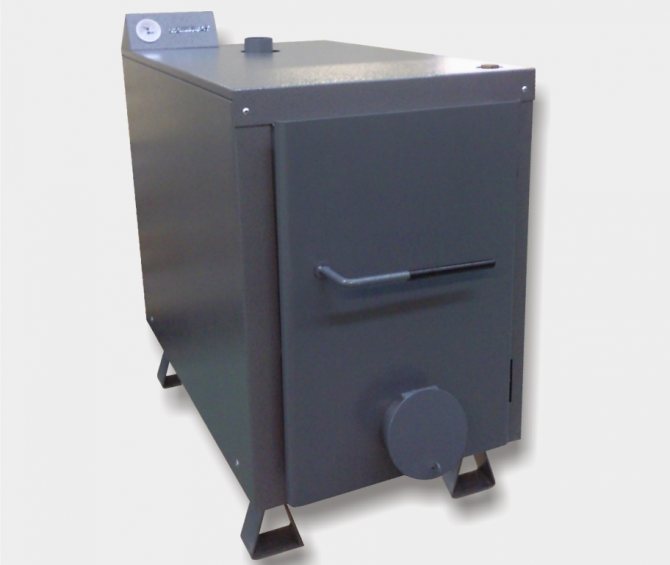

This boiler can be used not only for residential, but also for industrial or agricultural premises. It is allowed to be used both as the main or additional heating equipment. The main rule is that it should be located in a room equipped with a natural ventilation system. For higher efficiency, the device is equipped with a flue gas combustion system.
More: TOP-10 + best hair clippers, how to choose
The design has a heating element and a reliable traction control system. The main function of the heating element is to maintain the water temperature to prevent defrosting of the heating system. The unit works on the basis of natural circulation of water due to the temperature difference, however, the pipes will need to be positioned so that the coolant can pass through the system on its own. If it is not possible to provide it, then it will be necessary to additionally install a circulation pump and an expansion tank that has direct contact with atmospheric air. The maximum pressure at which this boiler can operate is 5 bar. The unit is designed for an area of up to 120 square meters.
Benefits:
- Easy to install;
- Reliable build quality
- The ability to use any solid fuel.
Disadvantages:
- The position of the damper must be adjusted manually to prevent excessive fuel consumption;
- Fast burning of fuel.
Lemax Forward-16
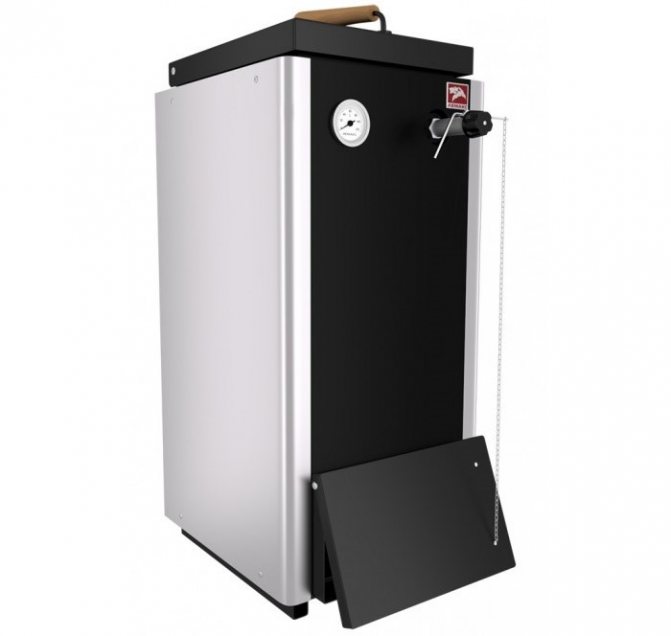

It is a fairly simple device, where nothing superfluous is provided. The design is very reliable, does not need maintenance, and has an affordable price. The body is made of decorative metal panels. Behind it is a layer of thermal insulation, under which there is a body made of mild steel 4 mm thick. The fuel chamber is large and protected from overheating by a water jacket.
In order to increase the strength of the equipment, the heat exchanger is reinforced with a channel, so that the probability of rupture is low. In the lower part of the device there is a heat-resistant grate, under which there is a box for slag and ash. It can be removed through the door on the front panel, it also serves as a damper that regulates the amount of air entering the combustion chamber from the room. The branch pipes through which the supply and return lines of the heating system are connected are located on the rear panel. There is also a chimney pipe with a damper that regulates the draft. The boiler can operate on wood or brown coal; for convenience, there is a top-loading fuel system.
Benefits:
- The ability to use any type of solid fuel - coal, coke, firewood, and so on;
- Small overall dimensions, no need for constant maintenance;
- Convenient top or side loading;
- Low cost.
Disadvantages:
- Low efficiency;
- The need to regularly load fuel, as it burns out quickly enough.
Kentatsu ELEGANT-03
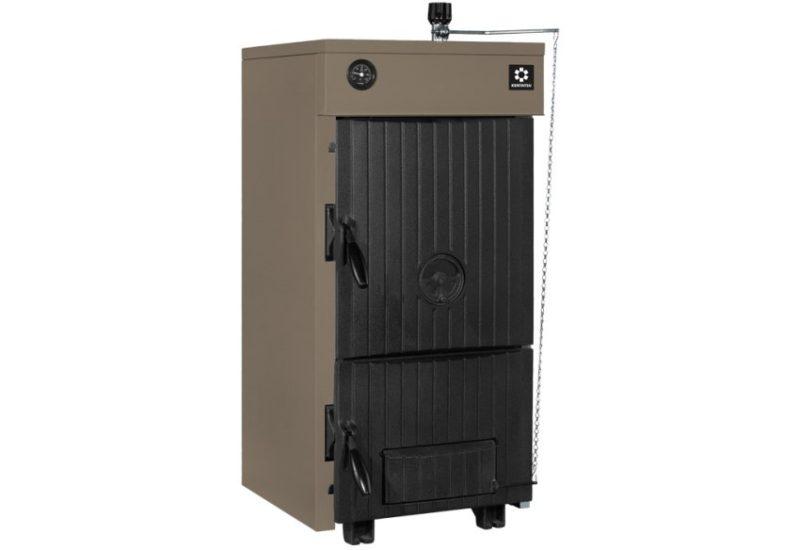

The device is a very durable and reliable product, which is designed for heating premises for various purposes. The control here is simple mechanical, you don't have to connect it to the electrical network. The device is capable of operating on coal and wood, it has a fairly hardy heat exchanger made of cast iron and can withstand serious physical exertion, including the high pressure of the coolant itself. The grates are cooled here, and the overall performance is high. The device is manufactured on the basis of a multi-section heat exchanger, which is manufactured using the new AminGas technology. It is resistant to corrosive processes and resists temperature stress well. The fuel is burned completely by supplying secondary air. The boiler is single-circuit, but it can also be adapted to supply hot water - for this you will need to purchase indirect heating boilers. They are connected to the heating circuit, part of the heat is taken from there and this energy is directed to spiral heat exchangers.
The combustion chamber is spacious, the loading door is also quite large, so it is easy to lay fuel. The temperature of the heating circuit can be controlled by mechanical draft control. The highest temperature of the coolant can be 90 degrees, the pressure should not exceed 4 bar. The boiler can be used in closed systems with forced circulation.
Benefits:
- Fairly acceptable cost;
- High performance;
- Acceptable dimensions;
- Universal apparatus;
- Good workmanship and assembly of the device;
- Long service life;
- There is no need to connect the product to the power supply.
Disadvantages:
- The ash pan is not very convenient - getting it out is problematic.
3. Teplodar Kupper OK 15
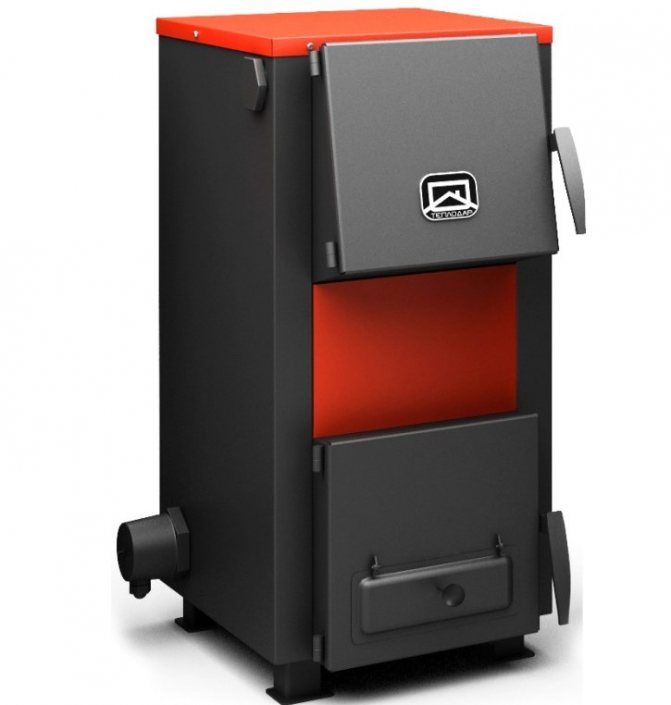

In the top of solid fuel boilers, this unit is in an honorable third place, largely due to the prolonged burning of fuel. So, on one tab of firewood, the equipment can work for about 30 hours, briquettes burn out in two days, coal for about 5 days. Perfect for residential, warehouse and even industrial premises, the area of which does not exceed 150 square meters.
More: TOP 10 best TVs with a diagonal of 43 inches
As a coolant, you can use both water and antifreeze, any solid fuel acts as a fuel - briquettes, firewood, coal. When installing additional elements, the boiler will operate on electricity or gas. The heat exchanger is made of 12 tubes, which ensures high efficiency of the device. The door is sealed, due to which smoke will not pass into the room, and the fuel will burn out much longer due to the weak access of oxygen to the furnace - it is based on the state standard GOST 9817-95.
Benefits:
- High build quality of the device;
- Profitability of work with significant efficiency;
- Excellent value for money.
Disadvantages:
- Considerable mass, which makes it difficult to move the boiler from one place to another.
Solid fuel boiler Week "KO-90"
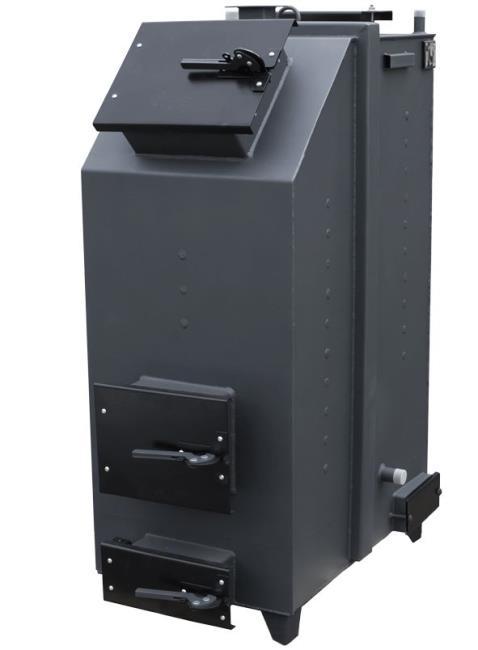

Heats rooms 150 - 400 sq.m. Ideal for a private house, cottage, car service, as well as a car wash.
On one load of 300 liters, it can work up to 7 days. Working power: 15-45 kW (regulated by automation). Peak power: 90 kW
Benefits:
- Mass production;
- Made of Russian steel 5 mm, grade 09G2S, manufactured by MMK;
- The hatch for cleaning the heat exchanger can be located both on the left and on the right;
- All stages of production are controlled;
- Insured liability to the consumer in ROSGOSSTRAKH in the amount of 10 million rubles;
- Patented production technology;
- Availability of documentation confirming fire safety, reliability in use.
Disadvantages:
- Weight and dimensions, but this makes the boiler reliable, with a good one-time load;
- The presence of condensate may seem like a minus, but this is an indicator of the high efficiency of the boiler, and there are effective ways to reduce it;
- Volatility. Undoubtedly a minus, but easily corrected, in the solution of which the house always becomes warm, regardless of whether there is electricity or not.
You can buy boilers Nedelka here.
Stropuva Mini S8
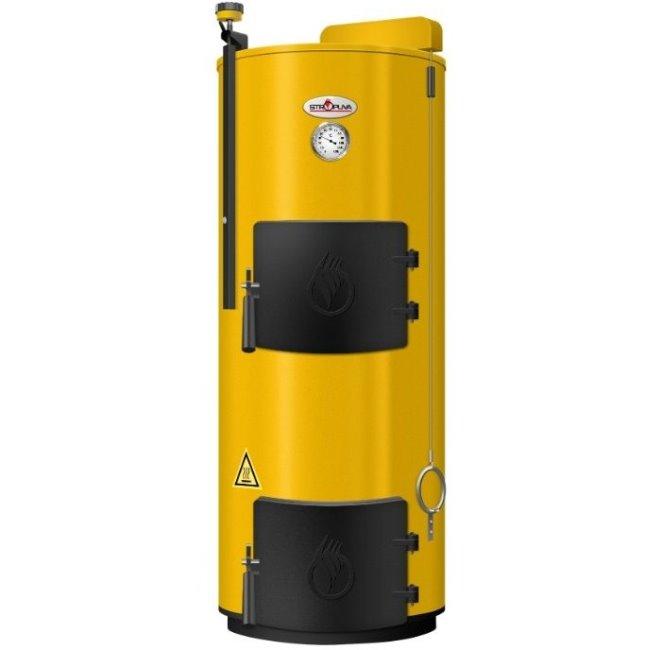

The leader of our review of the best solid fuel boilers is capable of high-quality heating of a room, the area of which reaches 80 sq. m. Coal, firewood, wood briquettes and so on can be used as fuel. The duration of burning on one tab of fuel is significant: ordinary firewood burns out in about 30 hours, briquettes - in 48 hours. These are the maximum parameters that can be influenced by the heat loss of the building, the temperature of the outside air, and the quality of the fuel. The overall dimensions are not too large, the boiler takes up a minimum of free space. The design is not too complicated - the apparatus consists of two cylinders placed one inside the other and made of steel. There is a layer of external thermal insulation, so it will not be possible to burn yourself against the walls of the boiler. The coolant flows through the space between these cylinders. Inside the smaller of them there is a combustion chamber, which is served through doors on the body of the device.
The combustion process itself occurs only in the upper layer of the fuel. Heated air from a special chamber is directed here through a telescopic tube. When the top layer of fuel burns out, the tube moves to the bottom layer, and so on. such a constructive solution allows increasing the efficiency of the apparatus, as well as adjusting the temperature of the coolant depending on the needs of the user. The combustion products, before entering the chimney, first flow around the air heating chamber, transferring their heat to it.
Benefits:
- Absolute non-volatility of the product;
- Reliable and safe design;
- Can heat a large area;
- It uses fuel sparingly.
Disadvantages:
- Except for a rather high cost, it was not found.
Number 3. Heat exchanger material
There are few options. Heat exchangers can be:
- steel;
- cast iron.
It is difficult to say unequivocally which solid fuel boiler is better to choose - it all depends on the budget, operating conditions and personal requirements. Manufacturers produce both boilers.
Cast iron heat exchangers have the following advantages:
- they are going to from separate sections, so their transportation and installation is easier. Moreover, if one of the sections is damaged, can be replaced, so durability such boilers at a height - up to 20 years or more;
- cast iron during operation is covered with a film of iron oxide. This is a dry rust that hardly progresses, protecting the rest of the material from negative effects. Cast iron more resistant to corrosion, therefore, the heat exchanger will have to be cleaned less often;
- cast iron keeps warm longer, that's a plus. The downside is that it warms up more slowly.
Among cons high weight, higher than steel, brittleness, and low resistance to thermal shock. With a sharp change in temperature, the cast-iron heat exchanger can easily crack, so avoid getting cold water into the still-hot heat exchanger.
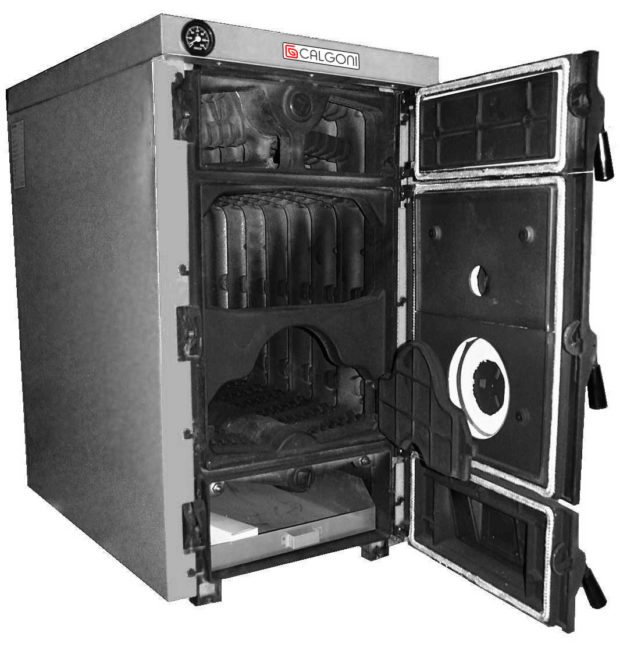

The advantages of a steel heat exchanger include:
- higher strength, and since such a heat exchanger is cooked in the factory and comes out in one piece, it becomes possible to manufacture combustion chambers of complex configurations, due to which the efficiency increases;
- high resistance to sudden temperature changes... Boilers with such heat exchangers, as a rule, receive more advanced automation, since the temperature can be controlled freely without fear of damaging the structure;
- not as high weight as cast iron;
- faster heating, but also faster cooling.
On the other hand, steel is more prone to development corrosion processes... Despite the resistance to temperature extremes, with frequent such fluctuations, cracks may appear at the weld points. In which case it will be impossible to repair the steel boiler - you will have to buy a new one, therefore, the durability of such structures is lower.
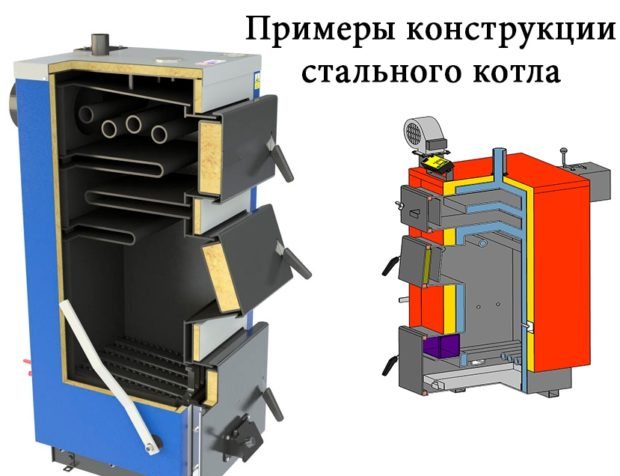

Automation and safety
Many modern heating systems are equipped with forced circulation devices. Such equipment is easier to design, install, and save money. Its only drawback is that there is a risk of disruption of circulation during heating. In this case, the coolant stops moving through the system, but the boiler continues to generate heat. And if the pipes in the system are plastic, they may well not withstand such a temperature load.
Therefore, the developers were forced to install automated solid fuel systems that independently monitor that the fan does not stop. After all, it is important not only to preserve the integrity and operability of the system, but also to ensure the safety of heating, to prevent a fire.
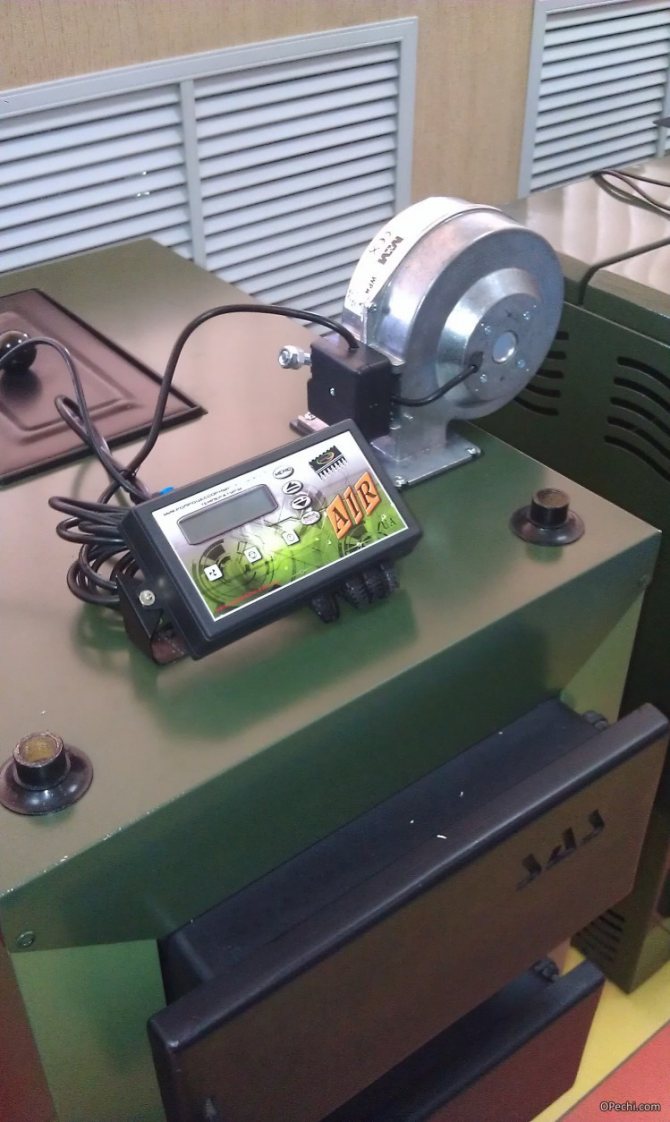

Boiler automation
An inexpensive solid fuel boiler can be equipped with a cooling heat exchanger, which is installed at the outlet of the device. Its inlet is equipped with a valve that opens if the temperature of the heating medium exceeds a critical value. In this case, cooling water enters the system, lowering the temperature indicator to a safe one.
Automated systems need to be supplied with electricity. Since this may cause interruptions in the operation of the equipment, the installation of uninterrupted elements does not interfere.
Demonstration of the operation of a solid fuel boiler
No. 4. Traction and energy consumption
Solid fuel boilers can be divided into two types:
- non-volatile natural draft... They do without special pumps, so they do not consume electricity. Classic boilers and some long-burning boilers function in a similar design. Well suited for areas with frequent power outages, can be used as a backup heat source;
- volatile with additional thrust... The design provides for a fan that helps air flow into the combustion chamber. In this version, most long-term combustion boilers, pellet and pyrolysis boilers are produced. Some settings can be made using the control panel.

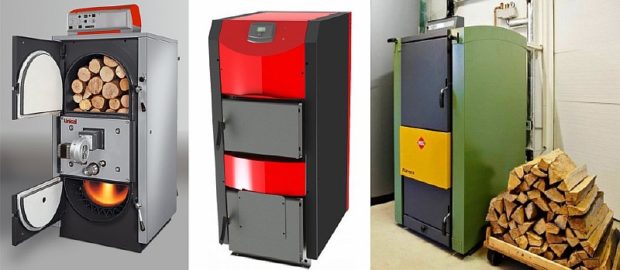
Modern solid fuel boiler types and models
The first thing that distinguishes boilers of different models and manufacturers is the fuel used for operation. The following fuels can be used in solid fuel boilers.
- Coal. For your country house, this is the best option. Its advantages are that you do not need to have a place for storing firewood, as is the case with a wood-burning boiler. In his work, he is completely autonomous. Not only fuel, but also the equipment itself has a low cost. Such boilers do not require expensive installation.
- Firewood and pellets. It combines high power, efficiency and economy. Such a boiler can be installed at any facility. Wood and pellets are easy to buy in any region, and the price will not be affordable, taking into account the economy of consumption, because the efficiency here reaches 90%.
- Pyrolysis boilers. They use solid biofuel. It can be agricultural and wood waste. At the output, we get high heat transfer and efficiency in the region of 85 - 92%. Before choosing a solid fuel boiler for long burning, you need to take all this into account and evaluate whether it will be easy to get the right fuel for it.
The final choice of fuel technology depends on the terrain and the desired operating algorithm. For example, if there is no possibility of a permanent connection to the power grid, then you need to choose boilers with fully autonomous operation and manual loading of consumables. Long burning solid fuel boiler can combine fuel materials at a consistently high efficiency.
No. 5. Number of contours
Single-circuit boilers responsible only for the heating system. There is also double-circuit boilers, which allow you to provide a hot water supply system for a private house. This is very convenient, but when calculating the required power, you should definitely take this feature into account. In addition, there are boilers equipped with hob.
Pay attention to the fact that solid fuel boilers are installed on the floor - there are no wall-mounted models.
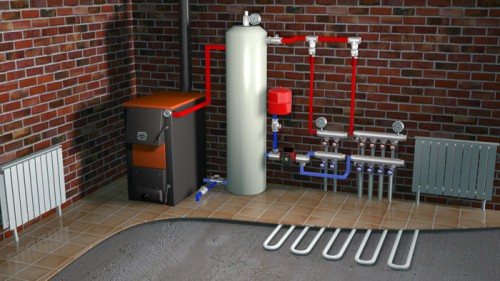

Pellet boiler
When considering pellet heating systems, it is worth starting with the disadvantages, since there are only two of them:
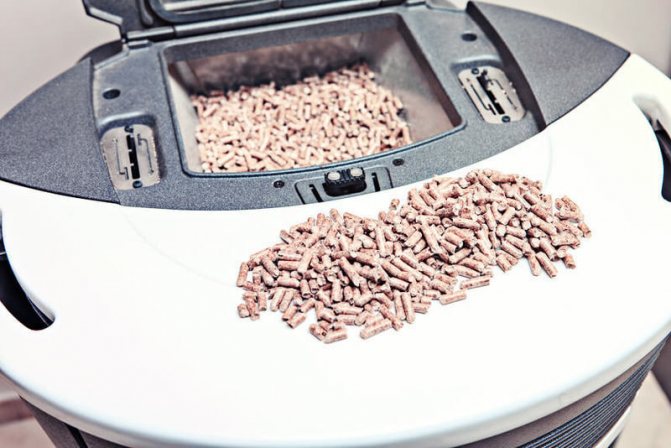

- high cost of equipment;
- the complexity of adjustment and repair, requiring the involvement of specialists.
Automatic coal-fired boilers operating on the pellet principle have an additional disadvantage - demanding quality and fraction of coals (size up to 80 mm). Now we list the advantages due to which this type of boilers is in demand:
- The use of a burner and high-calorific fuel increases the efficiency of the heat generator up to 80-85%.
- There is practically no inertia, because a small part of the fuel is constantly in the combustion chamber. After turning off the air supply, a small handful of pellets or coal remains smoldering.
- There is no need to install a buffer tank, although condensation protection is necessary.
- The boilers are fully automated and require human intervention once every 4-7 days to clean and add fuel to the bunker.
- The ability to program the operation of the equipment and control it from a distance via the Internet or mobile communication.
- No dirt and sawdust in the boiler room.
- Due to the fuel hopper, designed for 5-10 days of continuous operation, the pellet boiler takes up more space than the traditional one. But the level of comfort during operation is comparable to gas and electric heaters.
No. 6. Calculation of the power of a solid fuel boiler
One of the main indicators that you should first of all pay attention to when choosing a solid fuel boiler is its power, on which it depends on what area it can provide with heat. One should proceed precisely from the area of the heated room. You can use the generally accepted rule: for every 10 m2 of area, 1 kW of boiler power is needed. This is subject to normal thermal insulation and a ceiling height of no more than 3 m.
It turns out that a 15 kW boiler will be enough to heat a house with an area of 150 m2. Even at an external temperature of -360C, it will maintain the temperature in the house + 180C. With insufficient thermal insulation at home, as well as in a harsh climate, it is better to take a boiler with a small power reserve.
If the boiler is to be used in a hot water supply system, then this must be taken into account when calculating the power of the heat exchanger. Experts say that in order to ensure comfort in the house, the power of a double-circuit boiler in any case should not be lower than 24 kW. It is better to entrust more accurate calculations to professionals who will take into account all the features of a particular house and heating system.
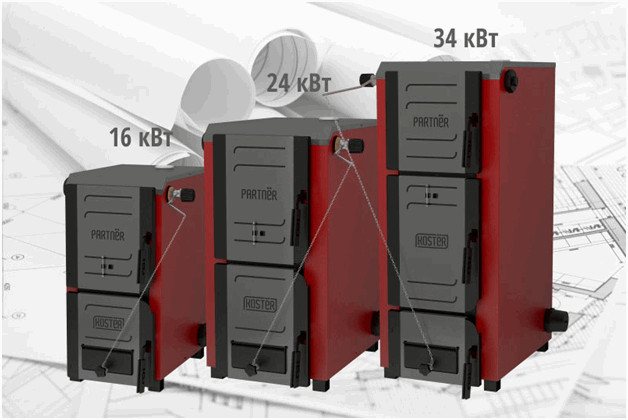

What material should a solid fuel boiler be made of?
Different alloys are used in different models. The selection is also based on the required power ratings, the fuel used and other factors. Let's list the popular alloys.
- Cast iron. Cast iron boilers are the most budgetary. It is recommended to choose them if coal will serve as fuel for work. Then you can achieve the highest efficiency rates. But in comparison with boilers based on other alloys, the efficiency is still reduced here.
- Steel. Steel boilers are more powerful and more ergonomic. Today on the market there are many models of solid fuel boilers made of steel of different thicknesses, heat exchanger design, efficiency indicators, and the time of continuous operation between fuel loads. The operating time of such boilers is on average 4-8 hours, so you do not have to constantly monitor the fuel, which is very convenient.
- Ceramics. Ceramic boilers are still a rarity now, but they are still the most efficient. Heat transfer is high, burn for a long time, quickly heat the coolant.
It should be borne in mind that ceramics are very expensive, but they are the most effective, cast iron is a cheap material, but still heats up for a long time and has an efficiency lower than steel. And steel is good, only it is considered less durable and undergoes oxidation over time, especially if the boiler was manufactured by an unscrupulous company.
No. 7. Fuel type
You can throw into the firebox of a solid fuel boiler firewood, coal, pellets and sawdust... It is a mistake to believe that the power of the boiler will remain unchanged, no matter what fuel is used. Many models of boilers can work with different types of fuel, but at the same time, the maximum power will be achieved only when using the fuel that the manufacturer has indicated as the main one. When using less high-calorie fuel, the power will drop by 25-30%, and if it is too wet, then the power drop can be up to 40%.
Average parameters of heat transfer for different types of fuel:
- firewood - 2500 kcal / kg. Logs of wood are usually 25-30 cm long and can be sawn or chopped. It is important that the wood is dry;
- anthracite coal - 7400 kcal / kg;
- hard coal - 7000 kcal / kg;
- brown coal - 3500 kcal / kg;
- pellets - 4500 kcal / kg.

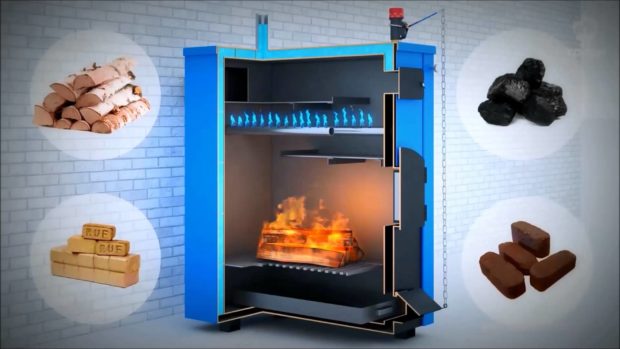
Classic direct fired boiler
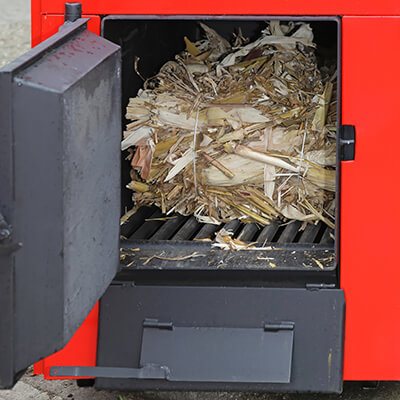

A traditional solid fuel boiler works more efficiently than any furnace, which is confirmed by an efficiency of 70%, maximum - 75%.
The advantages of the heating unit are not limited to this:
- the heater accepts firewood of any moisture content, coal and wood waste, briquettes;
- it is the most affordable among all solid fuel boilers;
- simple in design and maintenance;
- takes up relatively little space.
But there is an important point: in the case of purchasing inexpensive equipment, it may require additional investment and constant attention during operation.
It's all to blame for the negative aspects of classic units:
- The firebox should be frequently replenished with wood (once every 4-6 hours) and cleaned once a day. The exception is long-burning boilers operating from 1 load for 8-12 hours.
- Inertia. The burning of wood or coal in the furnace cannot be stopped instantly when the water has already warmed up. The boiler needs to discharge heat somewhere until the heating system needs it, for which an additional water tank (buffer tank) is used. When using raw firewood, the efficiency of the unit decreases sharply. Example: dry wood can provide about 4 kW of heat from 1 kg, and freshly cut - only 2 kW.
- If the combustion is slowed down by blocking the air, then the efficiency of the heat generator also drops by 10-20%. Steel heat exchangers need protection from condensation, and cast iron ones - from temperature shock. We will have to supply additional boiler piping elements - a mixing unit with a three-way valve.
In some cases, a solid fuel unit is poorly combined with a gravitational (gravity) heating system. The coolant flows through it very slowly, which can affect the cooling of the combustion chamber, which can cause the boiler to overheat and explode. It is necessary to put at least a circulation pump, or better also a buffer tank, it will serve as a heat accumulator.
No. 8. Combustion chamber volume
The larger the volume of the combustion chamber, the more fuel can be loaded, and the less often you run to the firebox and throw in a new portion. In the characteristics of the boiler, it is customary to indicate such an indicator as the ratio of the volume of fuel loading to the power of the boiler, measured in l / kW. Since a steel boiler with the same power as a cast iron boiler will have slightly more compact parameters, for it this ratio is 1.6-2.6 l / kW. For cast iron boilers - 1.1-1.4 l / kW. The higher this indicator, the less often you will have to run to the boiler.
For boilers with top loading fuel the useful volume is greater, and in this case the fuel is distributed more evenly. With front loading, especially when it comes to a cast iron multi-section heat exchanger, some effort will be required to evenly distribute the fuel.
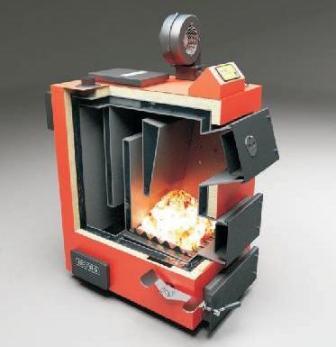

Pyrolysis boiler
Pyrolysis boilers will be your best choice, provided that you have a competent and balanced attitude towards them.
Sellers endow this type of boilers with often exaggerated advantages - combustion without smoke and ash, a duration of 12 hours from 1 tab and an efficiency of 83-89%. Such statements are a smart marketing ploy. These factors are really present and work, but only under the condition of a qualified approach to these boilers by the owner.
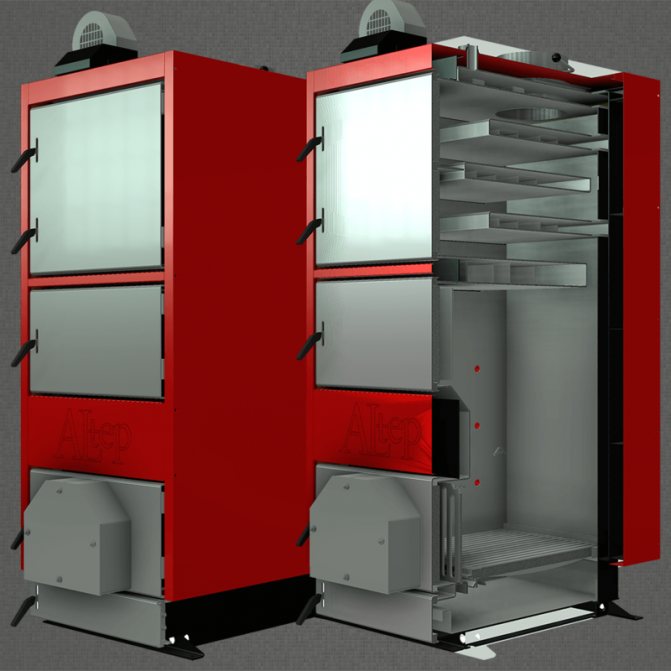

- The efficiency of a pyrolysis heat generator is 75-80% if you follow the recommendations and "feed" it with dry wood.
- Smokeless combustion also gives firewood with a moisture content of no more than 20%, only these are allowed to be used in this boiler.
- Since the air is blown by a fan, only light ash remains from the dried wood, which is blown into the chimney.
- The duration of work from 1 load is achieved by increasing the volume of the firebox.
The heating unit is called a pyrolysis unit, but boiler specialists call it the “upper blast apparatus”. It differs from the classic boiler with a fan in that air is forced from the furnace into the ash pan, and not vice versa. The ceramic baffle and the enlarged combustion chamber double the cost of the product compared to a traditional heater. In addition, the ceramics used in it have a limited service life.
There are no differences in the material and design of the heat exchanger, as well as in the features of operation. The same inertia, requiring the installation of a heat accumulator, plus protection against condensation and thermal shock.
An interesting point: using well-dried firewood and high-quality coal, the same excellent result can be obtained in an ordinary solid fuel boiler, which is 1.5-2 times cheaper.
No. 9. What else to consider when choosing a solid fuel boiler?
Obviously, even before buying a boiler, it is worth deciding whether the boiler will be the main source of heat or a backup one. In the latter case, it will be necessary to install an expansion tank or a heat accumulator - it is easier to do this right away than to upgrade the existing system later.
If in the future there is an opportunity switch to gaseous fuel, when choosing, you should pay attention to the possibility of transforming the boiler. Many traditional boilers can switch to gas by installing an inflatable burner. It is convenient, but it should be borne in mind that the efficiency of the converted boiler will be lower than that which was originally designed for gas.
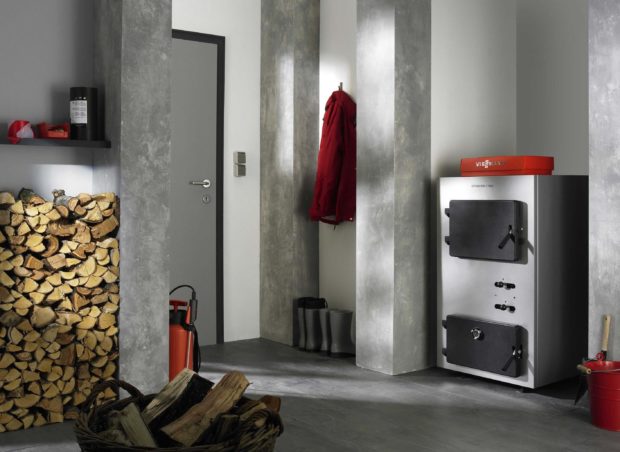

Switching to gas
Asking the question of how to choose a solid fuel boiler, many are thinking about whether the possibility of switching from solid fuel to gas is needed. If there is an interruption in the supply of any of the fuels, then the universal system is an excellent choice.
Such equipment can be used even if gas has not yet been supplied to the house, but it is planned in the near future. Then a season or several seasons can provide heating of the house with wood, and then switch to gas.
No. 10. Solid fuel boiler manufacturers
We will not open America if we say that quality largely depends on the reputation of the manufacturer. Large companies will not spoil their name with products of inadequate quality, so when choosing a solid fuel cat, it is better to pay attention to models from trusted manufacturers. This is the case when it is better not to save.
You can mark boilers of the following brands:
- Buderus - a German company that specializes in the production of boilers for various types and purposes. Solid fuel models run on different types of fuel, there are classic and pyrolysis boilers, there is enough power to heat large private houses;
- Bosch produces traditional non-volatile boilers;
- Ferroli Is a large Italian company that produces household and private boilers. Among the solid fuel boilers there are coal, wood and pellet boilers. The assortment is wide, the quality is high;
- SIME Is another Italian company that has made a name in just 35 years. Products are exported to 50 countries around the world, the range is represented by coal and wood-fired boilers;
- VIADRUS - Czech boilers. They are presented in a fairly wide range, are reliable, safe, and have a pleasant cost;
- Stropuva Is a Lithuanian manufacturer that often introduces new solutions in the field. The latest development is a 40 kW boiler with the ability to work from one load for 30 hours;
- Protherm - high quality Slovak cast iron boilers with high efficiency.
You can also note the products of domestic enterprises produced under the brands "Prometheus" (for houses up to 450 m2), "Hearth" (there are double-circuit boilers), "Zota" and "Smoke".
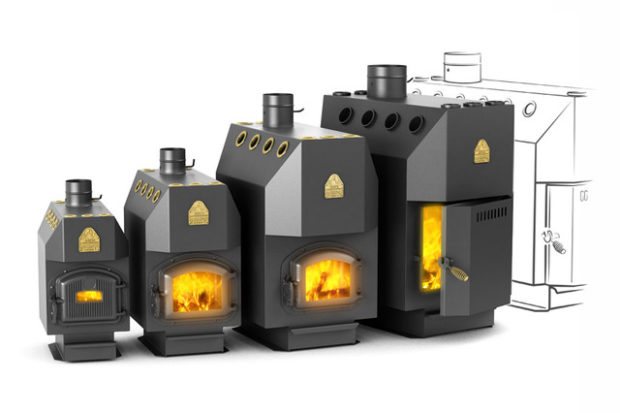

Solid fuel boiler selection guide
Boilers designed for burning various types of solid fuels are divided into the following types:
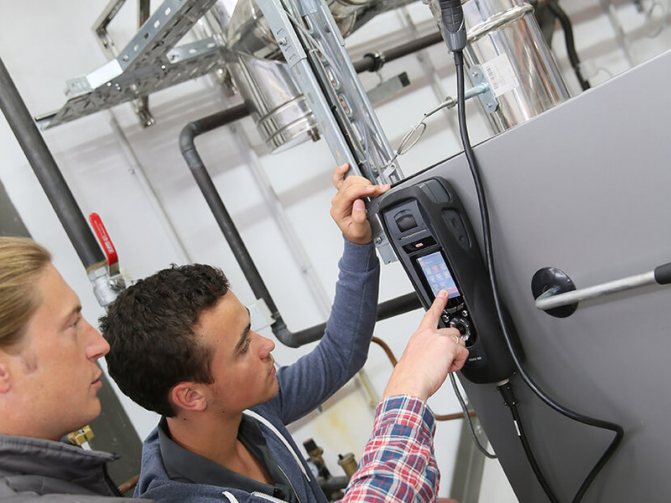

- Classic (traditional), direct burning. They act on the principle of a conventional stove, only instead of air they heat water for the heating system.
- Pyrolysis. In them, combustible gas is released from wood and coal during combustion, which is then burned in the secondary chamber, heating the coolant.
- Pellet and coal. Water is heated with the help of burners, where fuel pellets are fed automatically.
There are also specialized models that work on sawdust or chips, but they are not widely used due to their narrow focus.
- All of these boilers are sold in floor-standing design and can be equipped with a water circuit to provide hot water supply.
- Attempts to manufacture and sell wall-mounted solid fuel boilers were made, but were unsuccessful due to the high price of finished products and the lack of demand for them.
A traditional solid fuel boiler consists of the following basic elements:
- combustion chambers (firebox), where firewood is laid and burned;
- grate, playing the role of a platform for fuel;
- ash chamber (ash pan), where ash and ash are poured through the grate;
- a heat exchanger, where the heat of combustion is transferred to the water;
- a water jacket surrounding the firebox from all sides;
- air supply systems to the boiler furnace;
- control devices (manometer, thermometer).
The heat exchanger and the firebox are the most important elements made of thick steel (3-4 mm) or cast iron. The power of the boiler depends on their size.
Cast iron is more durable and more reliable than steel, but it is afraid of temperature changes and is more expensive by an average of 40%.
Thin metal (2 mm or less) is used for the water jacket.
There is a separate category - long-burning units that do not have a heat exchanger and are one large steel firebox surrounded by a coolant. The combustion process in it goes from top to bottom.
The principle of operation of a classic boiler
For comparison, let us recall how a classic solid fuel boiler works:
- Fuel (wood or coal) is placed on the grate and set on fire.
- In the process of combustion, the flame heats up the walls of the firebox and the coolant behind them.
- Before leaving the chimney, hot gases and smoke pass through a heat exchanger, where they give off most of the thermal energy to the same water.
- Combustion air is supplied through the ash pan door due to the chimney draft. The second method is air injection by a fan controlled by an electronic automation unit, depending on the readings of the sensors.
- The cooled coolant from the heating system enters the boiler jacket from below, and when heated from the walls of the furnace, it leaves the pipe in the upper part.
The principle of operation of the pyrolysis boiler
In pyrolysis boilers, the operation algorithm is somewhat different and takes place in 2 stages.
First stage
- Combustion of solid fuel occurs in the smoldering mode, in which flammable pyrolysis gas is released.
- From the action of the fan, which blows air into the main firebox, this gas rushes down and passes from the ash pan through the grate and a partition with a ceramic insert.
Second stage
- A hole (nozzle) is made in the ceramic insert, where the gas flows out. It burns out already inside the ash pan, creating a torch of flame directed downward.
- The bottom of the chamber is heated from it, behind which the water is located.
- Further, the process proceeds in the same way as in a classic heat generator.
Unlike traditional and pyrolysis units, the walls of the firebox of the pellet boiler are heated by the flame of the burner built into the loading door. It is able to ignite and turn off automatically under the control of the automation unit. Coal or pellets are fed in the required quantity to the burner by means of a screw conveyor.
Which boiler is better - evaluation criteria
Which boiler is better or worse will become clear already during the operation of the heating equipment. The only way to further avoid disappointment and eliminate additional costs is to correctly assess the existing solid fuel autonomous heating options. What are the evaluation criteria: better or worse for solid fuel units?
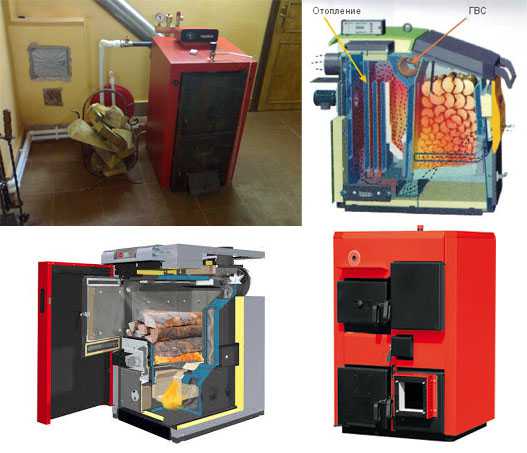

For heating technology, the following criteria are important:
- power of the proposed models of solid fuel boilers;
- availability of fuel, its cost;
- technological parameters of heating boilers;
- heating equipment safety;
- equipping with automatic control systems;
- the possibility of switching to gas heating.
Requirements for the desired power, fuel types determine the technological parameters of the units.These include the dimensions, the number of combustion chambers, the principle of operation, the method of loading the fuel.
Performance, performance, safety are also key aspects, based on which we can say for sure - this heating boiler is better than other models.
How to calculate optimal power parameters
As in the situation with gas boilers, the method for calculating the power of solid fuel boilers is carried out according to the same principle - 1 kW is required for heating 10 m2 of the indoor area. The height of the ceilings is also taken based on the average value - 3 m.
For instance: to heat a residential building or a small industrial building with an area of 150 m2, a solid fuel boiler with a capacity of 15 kW is required. Why? 150/10 = 15.
Sometimes the boiler output is calculated taking into account the internal volume of the room. Here it is already necessary to take into account such a factor as the thermal insulation of the room. To calculate a well-insulated and insulated room, a coefficient of 40 is taken. An insufficiently insulated building corresponds to a coefficient of 60. For a building with an area of 150 m2 with a ceiling height of 2.5 m, we make calculations
For instance:
150 x 2.5 x 40 = 15000 W (15 kW) - equipment power, optimal for heating a building with good thermal insulation.
150 x 2.5 x 60 = 22500W (22.5 kW) - the optimal power of the unit for heating a room with poor thermal insulation.
Important! Up to 50% of the design capacity must be added to the design capacity of the equipment used for hot water supply. For indirect heating of water in a boiler or for heating a heat exchanger, significant additional power and a larger amount of firewood or coal will be required.
For residential premises, the issue of providing hot water supply is especially relevant. In this situation, an important question should be resolved, which type is preferable for you and how much it will be required for the normal operation of the individual heating system.
What fuel to stop on
Today, a variety of fuels are used to operate solid fuel boilers:
- brown coal;
- coke;
- coal;
- peat;
- firewood, wood products.


It is a delusion to believe that the power of a heater, regardless of whether it is fired with wood, coal or pellets, will be the same. Each fuel has its own parameters of calorific value, therefore, respectively, in each case, the power of the apparatus and the volume of loading of the combustion chamber may differ.
For reference: less high-calorie fuel can lead to a drop in the power of a solid fuel unit by 20-30% of the design data. An unprepared fuel resource (high humidity) leads to even more noticeable power losses of heating equipment.
In the technical documentation for the heating device, manufacturers usually indicate the recommended type of fuel and alternatives. The main type of combustible material will increase the duration of the boiler equipment operation without interruptions. The best combustible material may have little effect if used in this type of equipment as an additional fuel.
For an optimal assessment of the quality of heating equipment, it is necessary not only to take into account the requirements for the power of the heater and the technological parameters of the fuel resource, but also to carefully study the varieties of existing solid fuel heating devices.
Advantages and disadvantages
You may be interested in the information - heating boilers for a private house
Solid fuel heating boilers are far from ideal heating installations. They, like other units, have their own advantages and disadvantages. Knowing the latter will help determine the choice of the model, as well as decide whether such a boiler is needed in the house.
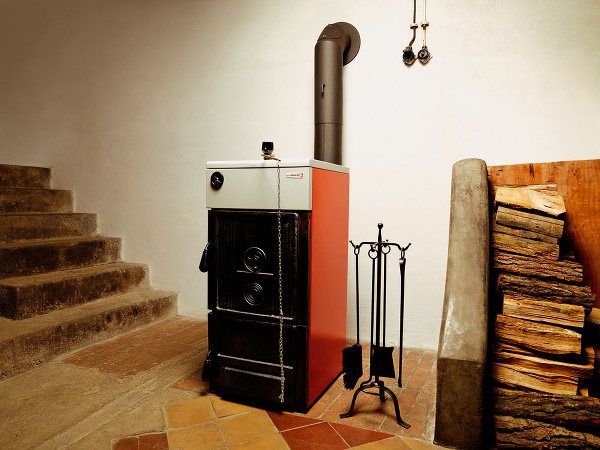

Solid fuel boiler has its advantages and disadvantages
Advantages of using solid fuel boilers:
- relatively low price, which was achieved due to the simplicity of the design;
- the possibility of using different types of fuel in one unit;
- the raw materials for the boiler are relatively inexpensive;
- a solid fuel boiler does not need to be connected to the mains, its operation does not depend on the availability of electricity in the house;
- high reliability of the installation - one might say, trouble-free operation;
- high level of heat transfer;
- it is possible to install such a unit without the consent of the supervisory authorities;
- a modern automated boiler should be fired up only once at the beginning of the season (some models);
- there is a large selection of boilers on the market;
- The efficiency reaches 85% or more.
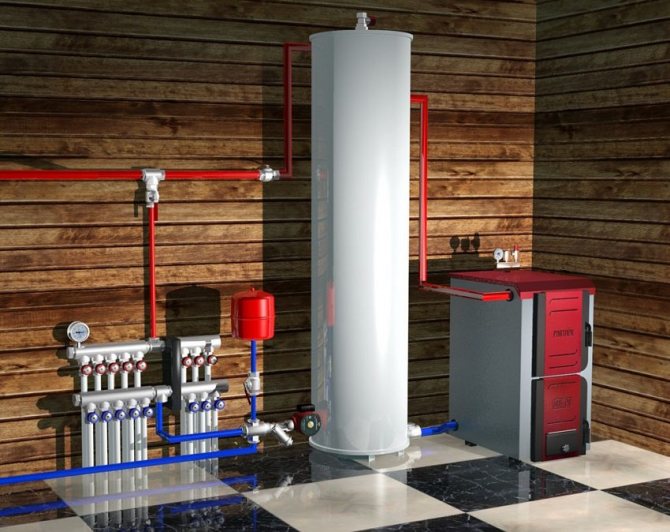

A modern boiler room in a private house is equipped with a double-circuit solid fuel boiler with a storage tank for hot water
Disadvantages of using solid fuel boilers:
- the installation requires regular cleaning of limescale and soot. Both significantly reduce the efficiency of the device, the boiler starts to heat worse, and the materials from which it is made may become unusable (for example, scale impairs the heat transfer from the heat exchanger to water, as a result, the metal overheats and its destruction);

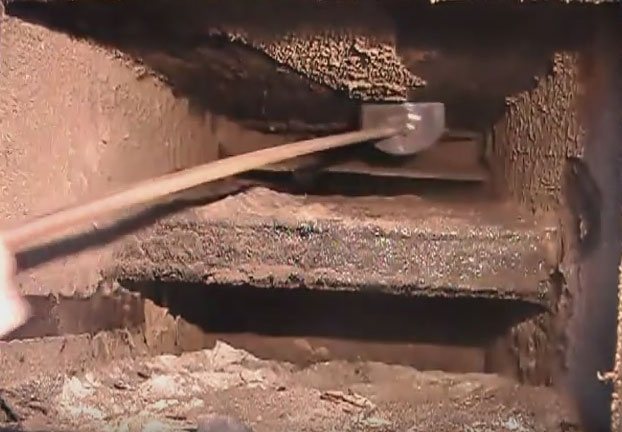
Cleaning a solid fuel boiler with a spatula
- a solid fuel boiler will not be able to work without human intervention - the fuel itself is not loaded into the combustion chamber. Fortunately, it is often not necessary to load it into modern automated boilers (1-2 times a week), but a classic boiler is loaded every 2-4 hours;
- you need free space for storing fuel;
- to avoid trouble, it is important to carefully follow all safety rules;
- boilers are afraid of overheating.
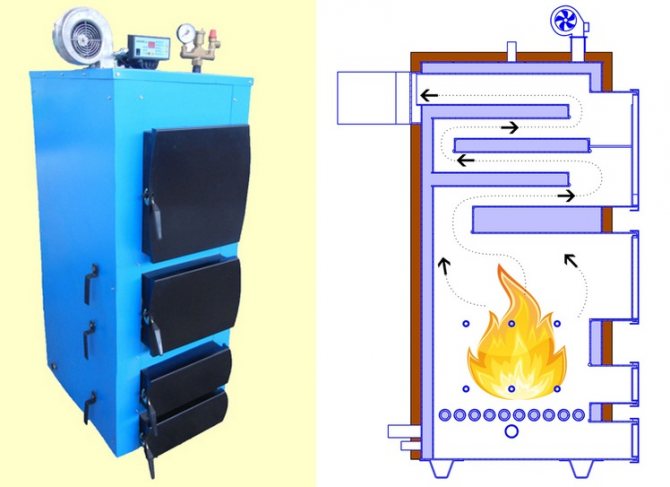

Top loading boiler

